Do you need help from experienced Independent Building Surveyors?
If you need help and advice with regard to building surveys, structural surveys, structural reports, engineers reports, specific defects report, dilapidations or any other property matters please free phone 0800 298 5424 for a friendly chat.

Typical heat loss in a traditional house
Some information about Milton Keynes

Plaque at Energy World in Milton Keynes
Milton Keynes, concrete cows and roundabouts!
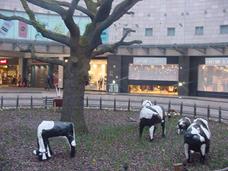
Concrete cows in Milton Keynes
For those of you who do not know it was a large area of countryside situated in central England. It is not too far away from the Stoke Mandeville area which, we believe, is the furthest point from any seaside resort as well as being home to the famous Stoke Mandeville Hospital.
Is Milton Keynes a town or a City?
Milton Keynes was built as a New Town but on a city scale but has not yet officially achieved City status. It was developed from the 1960s onwards and took its name from the original Milton Keynes village which is still there. In Milton Keynes village you will find the Swan Public House with its thatched roof, historic old buildings and its garden allotments.
Which villages are close to Milton Keynes?
Milton Keynes was built between existing villages many of which have a long history such as Woburn, famous for its Safari Park, Woburn Abbey (home of the Duke of Bedford) with its amazing 3000 acre Deer Park and Woburn Golf Club. Woburn Sands is a beautiful picturesque Georgian village although many of the properties have original Tudor structures. The village has some very pleasant walking and horse riding areas and quite amazing off road bike tracks (see WoburnTrails.co.uk).
Other surrounding villages include Wolverton, which is famous for being the centre of the railway maintenance and repair industry. You will also see some fantastic Victorian architecture and its scarecrow festival is definitely something worth taking the day off for. If our memory serves us correctly it was the first place in Britain to get acid rain caused by the railway works.
Stony Stratford, to the north, (see StonyStratford.co.uk) has a mixture of architectural styles as you walk down the High Street. The village is known for its two pubs in the high street, The Cock and the Bull, where it is rumoured that the phrase Cock and Bull story originated from. If you do have the time to visit the village, it is very old and historic and we believe it was mentioned in the Doomsday Book.
For those people that live in Milton Keynes it is a very green area. It was recorded as having 20 million trees in 2006, which almost makes it a forest. The town is laid out in a grid system with ‘V' being the vertical roads and ‘H' being the horizontal roads, you will know what we mean if you visit Milton Keynes.
Milton Keynes is home to the Open University and famously has an indoor ski and snowboarding slope with real snow and is known for bringing Wimbledon Football Club to Milton Keynes which has now been renamed MK Dons.The town has had many firsts but the ones we know about are the multiplex cinema that was the first in the country and indeed the first cinema to be built for many years. It also has 125 miles of cycle ways and footpath networks known as the Redway system, where you can travel about Milton Keynes without seeing a car.
Milton Keynes Energy World 1986
Milton Keynes staged an exhibition of houses that looked at the best way of conserving energy, known as Eco houses today. Ironically it has been short listed as an area for a New Eco Town nearly some fifty years on which does beg the question what did we learn from the Milton Keynes Energy World 1986. Probably the first thing to be said about the success or lack of success of the project is how difficult it is to find out any information on it. The project was known as Energy World (this was before such terms as sustainability and Eco were known!). The estate was constructed in Shenley Lodge, near the Milton Keynes Bowl by the Milton Keynes Development Corporation, which has had various other names including English Partnerships.

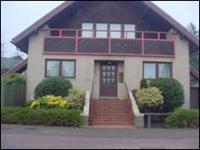
It was opened to the public during the Autumn of 1986 and at the time it attracted interest worldwide. Most importantly it is said to have had a long term impact on improvements of thermal efficiencies in properties in the UK via Building Regulations. The houses ranged from those built into the ground to quite traditional properties. The original criteria were for these houses to be 30% more efficient than the Building Regulations at the time. Much guidance was taken from Canada and the houses achieved a Canadian rating of R2000 being the first in the country to achieve this standard.
Interestingly in 2004 it was said that the houses were selling at 3% above the price of other houses in the area, we would comment that recent research that we have been involved with, with Anglia Ruskin University considers there to be a price advantage as opposed to just a preference advantage to having an energy efficient property interestingly.
Energy World was measured by the Milton Keynes Energy Cost Index (MKECI) which was launched as a national home energy rating system the NHER in 1990 and in 1995 this became the SAP rating and in 2007 became the Energy Performance Certificate EPC.
BedZED Sutton
It is also worth having a look at BedZED in the London Borough of Sutton built in 2002 which has been built as a zero energy project only using energy that is renewable. It has 777m² of solar panels and is of course south facing for solar gain complete with triple glazing with high thermal insulation.
Energy Park Milton Keynes
Following on from Energy World a further 1200 dwellings were built with energy efficiency as the core idea in Shenley Lodge and standards applied generally to Milton Keynes.
Pennyland Project Milton Keynes
In the 1970s 177 buildings were built on the Pennyland Project which was very much an experimental low energy building development. Half the development was built to the future proposed Building Regulations for 1982 and half were built to the Danish standards in 1977 and the two were compared.
Pennyland area two, Linfold, was also an area where low energy building was carried out with further developments at Neath Hill. To give an indication as to how far we have come with the development of energy efficiency buildings the Pennyland area one houses featured 80mm of loft insulation. Today houses typically have 270-300mm, with 50mm of cavity insulation, this is now a minimum often with the internal walls being dry lined. Pennyland properties were single glazed and used passive solar layouts and features which is something that perhaps is not used today, these were the ones built to the proposed 1982 Building Regulation Standards.
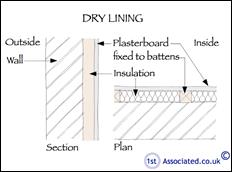
Dry lining
The ones built to the Danish BR1977 standard, which was much higher, used 150mm of loft insulation, 100mm cavity wall insulation, double glazing, 75mm insulation to the floors and again they used passive solar layout and features. Monitoring was carried out in the years 1981 and 1982.
The Pennyland project was managed by the Open University Energy Research Group. Interestingly the experimental buildings of 1986 were only surpassed by the Building Regulations in 2002 and it could be argued that we have wasted decades. The Pennyland project was a whole estate set out and planned according to passive design principles. 177 houses were built following studies which led to the house designs used, and the houses were used to study the effects of different levels of insulation and passive solar energy techniques on domestic fuel consumption.
The projects explored various concepts, these were solar gain, a passive solar layout and features, insulated cavity walls and thermal mass (also known as the thermal fly wheel effect).
The website, thenaturalhome.com, discusses the concept of high thermal mass and also talks about orientation which plays a major role in any passive solar design, probably the quote of the website says that any definition of sustainable design should include the word healthy. There are three key elements to a healthy home which is ventilate, ventilate and ventilate and it argues that we are going down the wrong tunnel with passive solar architecture which relies upon air tightness and high insulation levels for energy efficiency, as we do in our Building Regulations, as it is not a healthy environment. High Thermal Mass buildings (HTM) have heating and cooling of a building and as the walls store heat it allows ventilation without losing all the heat and we would agree that this has fresh areas vital to a healthy home.
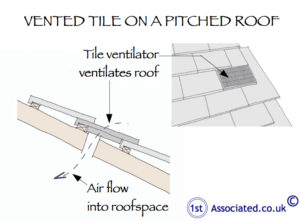
Roof ventilation
The website also has an interesting quote about using alternative type materials such as straw bales, stuffed car tyres, sandwich insulation panels (which are getting quite popular). They then say that concrete is the best as, although it does not have the greatest sustainable credentials, at the end of the day you will be able to sell it because it will be mortgageable.
Knowlhill, Milton Keynes commercial property energy efficiency
Knowlhill was the industrial section of The Energy Park and as such any buildings had to be of a higher standard. Five offices were built including The Royal Mail Parcel Force building, also home to the National Energy Foundation (which occupies a low energy building), the United Sustainability Agency, Zero Carbon Hub and National House Building Council. The Zero Carbon Hub has a lead role in the Zero Carbon Standard of 2016 that the government has proposed together with the development of Part L of the Building Regulations.

BRE Eco Energy Efficient Sustainability Developments
This is the first Code Level 6 of sustainable homes which internally meets the government criteria for zero Stamp Duty built by national house developer Barratt Development Plc. Key features it uses are triple glazing, window shutters, heat recovery systems which re-circulates air, known as the greenhouse.
The Hanson Eco House key features built in 2007 was the first masonry house to achieve Code 4 under the Sustainable Homes described as having a distinctive appearance:-
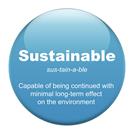
• Thermal mass
• Natural ventilation with a central stair core
• Solar collector
• Ground source heat pump
Kevin McCloud of Grand Designs and the Building Research Establishment (BRE)
They have teamed up to build a prefabricated energy efficient building originally seen on Channel 4's 2008 Grand Designs Live. This is being built by Brighton & Hove City Council and interestingly it is meant to have a life span of 5-10 years. We would need a further explanation as to how this is a sustainable construction.
Oxley Woods the new Energy World or as it would now be called Eco Housing marketing or a step forward?
As part of the governments challenge to build a house for £60,000 or, to be more exact, 30% of the housing on an average housing estate can be built for £60,000 or less including the cost of land. One test was held with the proto-type property being built in Derby which then went on to be built as part of a 145 house development in Oxley Woods, Milton Keynes. Ironically it is not that far away from the Energy World site built in 1986.
These properties at Oxley Woods were built in 2007 and were part of a collaboration between George Wimpey, the house builders and general commercial contractors and the new Richard Rogers Partnership, known as Rogers Stirk Harbour plus Partners (RSH-P) and were set on the west side of Milton Keynes. Working together they came up with buildings that not only met the price dynamics but also they took the sustainable building process a step forward.
From what we understand there were two main concepts which were used, one was a zone concept. The zone concept is where bathrooms, kitchens and stairways are gathered together and the remaining living rooms and bedrooms are then attached to these. The second concept used was the Eco hat which as far as we are aware is not a trademarked or copyrighted name, so apologies to George Wimpey if it is. The unit they described as a new chimney which was put at the top of the service spine, as it is referred to, and is from what we understand an air exchange system although it does not use that term.
So what do the Oxley Woods Eco Houses look like?
We have been to look at these houses and they look very different to a typical brick or stone traditional house. They have a rain cladding exterior which is often used on commercial properties although we have come across it being also used on large flat developments, we assume it is therefore an economical option. Unfortunately the example that we were involved with was a proposed legal case against the failure of this system protecting from the rain. We are not aware of the outcome of this case or indeed if it has gone to Court as many cases such as this are settled on the Court doorsteps under the no publicity clause.

Facts and Figures about the Eco Hat
It is said to have without its hat 27% reduction in carbon dioxide emission compared with a conventional new house. With its Eco hat it has a 40% reduction when compared against conventional new homes and it is commented that this rises to 50% when used to top up energy for a hot water system.
Independent Surveyors
If you truly do want an independent expert opinion from a surveyor with regard to building surveys, structural surveys, structural reports, engineers reports, specific defects report, dilapidations or any other property matters please contact 0800 298 5424 for a surveyor to give you a call back.
What do the ovals and circles in our building surveys means?
Within our reports we utilise a system of ovals and circles to highlight problem areas or characteristics within a property to better explain the issues. If this does not explain the issue completely then we can also use one of our sketches that have been commissioned exclusively for us for use in the reports.

Venting the roof
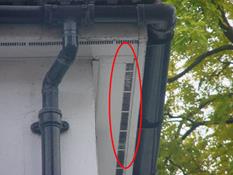
Vents in the fascias and soffits
Compare our Building Surveys but don't compare Apples with Thursdays
If you require a Building Survey or a Structural Survey on a home, house or commercial property we believe as Building Surveyors we have a wealth of experience and expertise that we can utilise to help you.
We are more than happy to send you examples of our Surveys that we have carried out on similar properties to yours and pretty much have always carried out a survey on similar property to the one that you are looking at although we do appreciate that all properties are unique.
We really believe that you should see what you are getting in the form of an example Survey before you purchase a property. What is more is that we are so confident with our higher than average standards that we believe that there is no other comparable survey available in the UK property and surveying market.
All rights reserved by 1stAssociated.co.uk
All rights are reserved the contents of the website are not to be reproduced or transmitted in any form in whole or part without the express written permission of www.1stAssociated.co.uk.co.uk
